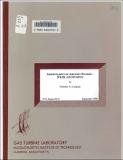| dc.contributor.author | Cumpsty, N. A. | en_US |
| dc.contributor.other | Massachusetts Institute of Technology. Gas Turbine Laboratory | en_US |
| dc.date.accessioned | 2016-10-06T21:22:24Z | |
| dc.date.available | 2016-10-06T21:22:24Z | |
| dc.date.issued | 1992 | en_US |
| dc.identifier.uri | http://hdl.handle.net/1721.1/104750 | |
| dc.description | September 1992 | en_US |
| dc.description | Includes bibliographical references (leaves 21-22) | en_US |
| dc.description.abstract | Summary: Attempts to understand and predict the aerodynamic behaviour of compressors and turbines in aircraft gas turbines have been encouraged by the intense competitive pressure which exists. Many of the apparently most difficult problems have been overcome using suitable numerical analysis, for example the calculation of three-dimensional transonic flows has been particularly successful. It is seemingly paradoxical that the numerical methods are relatively very good for flows which are traditionally regarded as difficult, but do less well at predicting efficiency when the flow is well behaved in the conventional aerodynamical sense, such as fully attached flows. The numerical methods do not necessarily give insight into the flow that is seen as most helpful to the designer and it can be useful to complement them with simpler approaches to the problem which seek to capture the essential features of the flow. The aerodynamics of aircraft engine fans are used to illustrate these points. Although numerical methods have been very successful with aeroengine fan blading they have been less successful with the multistage compressor. The reasons for this, primarily the difficulty of prescribing the boundary conditions, are discussed in this paper. The analysis of flow in multistage compressors still stumbles along with empirical methods, much of it based on data published over twenty years ago. A second area where stumbling has occurred is the prediction of flutter of blading, particularly fan blading; as recently as 1990 there were major in-flight failures due to flutter of a fan in civil airline service. To this day there is no reliable method of predicting the operating boundaries of flutter, and testing the engine over the entire operating range of altitude and speed is the only reliable method of ensuring safe operation. | en_US |
| dc.description.sponsorship | Supported by the Dept. of Aeronautics and Astronautics at MIT | en_US |
| dc.format.extent | 49 leaves | en_US |
| dc.publisher | Cambridge, Mass. : Gas Turbine Laboratory, Massachusetts Institute of Technology, 1992 | en_US |
| dc.relation.ispartofseries | GTL report #213 | en_US |
| dc.subject.lcc | TJ778.M41 G24 no.213 | en_US |
| dc.subject.lcsh | Aircraft gas-turbines | en_US |
| dc.subject.lcsh | Flutter (Aerodynamics) | en_US |
| dc.title | Aerodynamics of aircraft engines : stride and stumbles | en_US |
| dc.type | Technical Report | en_US |
| dc.identifier.oclc | 27350778 | en_US |
